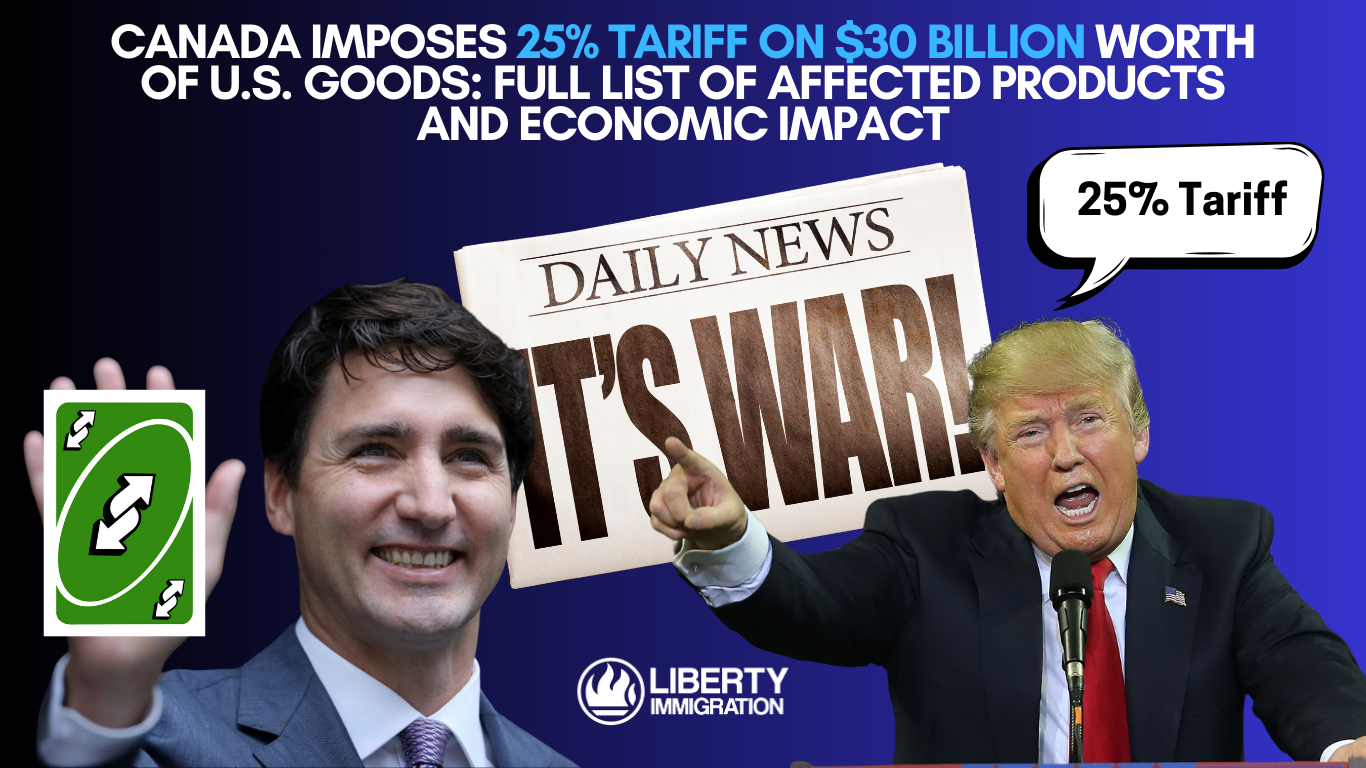Canada Imposes 25% Tariff on $30 Billion Worth of U.S. Goods: Full List of Affected Products and Economic Impact

In a bold move to counter ongoing trade disputes, the Canadian government has announced a 25% tariff on $30 billion worth of goods imported from the United States, effective February 4, 2025. This decision marks a significant escalation in trade tensions between the two nations and is expected to have far-reaching implications for businesses, consumers, and the broader economy.
Below, we provide a comprehensive breakdown of the affected products, the economic and consumer impact, and what this means for the future of U.S.-Canada trade relations.
Key Highlights
- Effective Date: February 4, 2025.
- Tariff Rate: 25% on $30 billion worth of U.S. goods.
- Objective: Countermeasure against U.S. tariffs on Canadian products.
- Exemptions: U.S. goods already in transit to Canada as of February 4, 2025, will not be affected.
Full List of U.S. Goods Affected by the 25% Tariff
The tariffs target a wide range of products eligible to be marked as “Made in the USA” under the Determination of Country of Origin for the Purposes of Marking Goods (CUSMA Countries) Regulations.
Here’s the complete list of affected goods:
1. Agricultural and Food Products
- Live poultry (chickens, ducks, geese, turkeys, guinea fowl).
- Fresh, chilled, or frozen meat, poultry, and edible offal.
- Pig fat, poultry fat, and dairy fats.
- Milk, cream, yogurt, buttermilk, whey, and kefir.
- Butter, cheese, and curd.
- Eggs and natural honey.
- Fresh or chilled tomatoes, legumes, fruits, and nuts.
- Citrus fruits (oranges, grapefruits, lemons).
- Melons, papayas, apricots, cherries, peaches, and plums.
- Coffee, tea, and spices (pepper, cinnamon, nutmeg, ginger, etc.).
- Wheat, rye, barley, oats, and rice.
- Vegetable saps, extracts, and oils (groundnut, palm, sunflower, rapeseed).
- Margarine and butter substitutes.
- Sausages and prepared meat products.
- Crustaceans, mollusks, and fish oils.
- Sugar, molasses, and sugar confectionery.
- Chocolate, cocoa, and white chocolate.
- Malt extract, pasta, bread, pastry, and bakers’ wares.
- Pizza, quiche, peanut butter, and fruit juices.
- Sauces (soy sauce, ketchup, mustard), soups, and broths.
- Ice cream, syrups, beer, wine, and spirits (rum, whiskey).
- Tobacco, cigars, and cigarettes.
2. Consumer Goods
- Beauty and makeup products.
- Shampoos, hair products, and oral hygiene items (toothbrushes, dental floss).
- Personal deodorants, antiperspirants, and shaving products.
- Soap, bath salts, and bath products.
- Tableware, kitchenware, and floor coverings.
- Self-adhesive plates, sheets, film, foil, and tape.
- Baths, sinks, washbasins, and toilet seats.
- Sacks, bags, and packing containers.
- Doors, windows, shutters, and blinds.
- Saddlery, harnesses, and luggage (suitcases, handbags, wallets).
- Clothing, apparel, footwear, and hats.
- Blankets, rugs, bed linen, and kitchen linen.
- Furniture (wooden, plastic, office, and mattresses).
- Lighting fixtures (chandeliers, lamps, Christmas lights).
- Paintings, drawings, and pastels.
3. Industrial and Mechanical Goods
- Rubber used in tires and other products.
- Wood products (sawn wood, plywood, particleboard, fiberboard).
- Builders’ joinery and carpentry (flooring panels, beams).
- Mechanical and chemical wood pulp.
- Paper products (toilet paper, facial tissue, envelopes).
- Tools (pliers, spanners, wrenches, knives, razors).
- Padlocks, locks, and clasps.
- Fans, pumps, compressors, and ventilating hoods.
- Refrigerators, freezers, and dishwashers.
- Lawn mowers, snowplows, and harvesting machinery.
- Washing machines, vacuum cleaners, and food appliances.
- Shavers, hair clippers, and irons.
- Ovens, cookers, toasters, and rice cookers.
- Electronic cigarettes and vaporizing devices.
4. Specialty Items
- Motorcycles and unmanned aircraft.
- Firearms (revolvers, pistols, shotguns).
- Bombs, grenades, torpedoes, and missiles.
- Video game consoles and playing cards.
- Cigarette lighters and non-electrical lamps.
Economic and Consumer Impact
The imposition of these tariffs is expected to have significant ripple effects across the Canadian economy:
- Higher Consumer Prices:
- The 25% tariff will likely lead to increased prices for affected goods, particularly in categories like food, beverages, and consumer electronics.
- Retailers may pass on the additional costs to consumers, impacting household budgets.
- Supply Chain Disruptions:
- Businesses reliant on U.S. imports may face challenges in sourcing alternatives, leading to potential shortages or delays.
- Small and medium-sized enterprises (SMEs) could be disproportionately affected.
- Shift to Domestic or Alternative Markets:
- Canadian consumers and businesses may turn to domestic products or imports from other countries (e.g., Mexico, EU, Asia) to avoid higher costs.
- Impact on U.S. Exporters:
- U.S. businesses exporting to Canada may see a decline in sales, prompting them to seek exemptions or lobby for policy changes.
Business and Policy Response
- Canadian Retailers: Many are already exploring alternative suppliers and adjusting pricing strategies to mitigate the impact.
- U.S. Businesses: Likely to engage in lobbying efforts to reverse the tariffs or seek exemptions for specific products.
- Government Stance: The Canadian government has framed the tariffs as a necessary measure to protect domestic industries and jobs, emphasizing reciprocity in trade relations.
Looking Ahead: What’s Next for U.S.-Canada Trade Relations?
The coming weeks will be critical as both nations navigate this new phase in their trade relationship. Key developments to watch include:
- Diplomatic Negotiations: Potential talks to de-escalate tensions and resolve underlying disputes.
- Retaliatory Measures: Possibility of further tariffs or trade restrictions from the U.S.
- Long-Term Implications: How these tariffs will shape future trade agreements and economic policies.
What This Means for You
- Consumers: Be prepared for potential price increases on affected goods. Consider exploring domestic or alternative import options.
- Businesses: Review your supply chains and explore diversification strategies to minimize disruptions.
- Stakeholders: Stay informed about policy updates and engage with trade experts to navigate the changing landscape.
Conclusion
The imposition of a 25% tariff on $30 billion worth of U.S. goods is a significant development in the ongoing trade disputes between Canada and the United States. While the immediate impact will be felt by consumers and businesses, the long-term consequences will depend on how both nations address the underlying issues.
For the latest updates and expert insights, visit the Canada Border Services Agency (CBSA) website or consult with trade professionals.
- Canada Border Services Agency (CBSA) – For updates on tariffs and trade policies.
- Global Affairs Canada – Official government resource on international trade.
- U.S. Trade Representative (USTR) – Insights into U.S. trade policies and disputes.
- Statistics Canada – Data on trade volumes and economic impact.
- World Trade Organization (WTO) – Global perspective on trade disputes.
- Canadian Federation of Independent Business (CFIB) – Impact on small businesses.
- Retail Council of Canada – Consumer and retail industry insights.
- Agriculture and Agri-Food Canada – Impact on agricultural products.
- Bank of Canada – Economic analysis and inflation trends.
- Canadian Manufacturers & Exporters – Manufacturing sector impact.
- International Monetary Fund (IMF) – Global economic implications.
- OECD Trade Policy – Trade policy analysis.
- Trade Data Online – Canadian trade statistics.
- U.S. Census Bureau – U.S. export data.
- Canadian Chamber of Commerce – Business advocacy and resources.
- Export Development Canada (EDC) – Support for Canadian exporters.
- Trade Commissioner Service – Government trade resources.
- Canadian Pork Council – Impact on pork and meat industries.
- Dairy Farmers of Canada – Dairy industry perspective.
- Canadian Sugar Institute – Sugar industry impact.
- Wine Growers Canada – Wine and spirits industry insights.
- Canadian Automotive Partnership Council – Automotive sector implications.
- Canadian Agri-Food Trade Alliance – Agri-food trade analysis.
- Canadian International Freight Forwarders Association – Logistics and supply chain impact.
- Canadian Press – News coverage on trade disputes.



